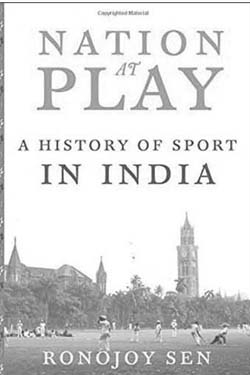Sports is war minus the shooting — George Orwell
Ronojoy Sen’s work suggests that the history of sports in India is much more than mere pastime and play. A study of the chequered history of sport would for Sen reveal much about the nature of Indian society, its values, ethics, aspirations, fissures, and very importantly the dynamics of power play. As Sen’s book succinctly portrays, the saga of sports in India has been inextricably bound with issues of class, identity mobility and patronage. Politics has never been very far from the field of sports in India.
Sen thus attempts a long-duree history of sports in the subcontinent where he seeks to place sports in its wider setting. He begins by dwelling on the culture of sports in ancient and medieval India and delves into the epics looking for a code of ethics as far as sports was concerned, the argument being epics like the Mahabharata were representative of the pulse of the people. He argues that certain sports such as wrestling, boxing and acrobatics were popular right from the hoary past to that medieval era. There was however a clear class divide whereas wrestling and boxing were considered sports to be pursued by the lowly while sports like chariot racing for instance were elite sports.
Sen. also talks of a certain class of professional wrestlers called ‘Jyesthimallas’ or jethis hailing originally from the Gujarat region who were Brahmins by caste. The ‘Mallapurana’ considered to be the first manual on wrestling has it that it was Krishna who persuaded the Brahmins of this region to practice wrestling by convincing them that it was necessary for protecting their dharma. The ‘Jyesthimallas’ developed into a distinct class of wrestlers.
Sports like wrestling had strict rules and were patronized actively by the ruling elite. A successful wrestler or boxer could possibly amass riches through the patronage of the elite and earn renown among the masses. Sen however does not tell us how the class of Brahmin wrestlers was viewed by society. Did their high ritual status confer on them a higher status than the average wrestler? How did the rest of the wrestling community hailing from more modest origins look upon them? How did their status evolve over a period of time?
Sen also does not question why it is that we have no ancient traditions as far as events like Track and Field are concerned? Or is it that there is a paucity of sources from where we can stitch a tale? Or does the lack of sources itself tell a story?
During the medieval period the patronage of sports like wrestling by both the Hindu and Muslim kings continued. The courts of Akbar and Krishnadeva Raya for instance patronized wrestlers and both these rulers were no mean wrestlers themselves. Princely houses continued to promote wrestling which was immensely popular in both urban and rural areas. Some wrestlers like the legendary Gama (though he died in obscurity) became cult figures and indeed earned international renown. Yet professional wrestling remained a preserve of rural and often illiterate Indians. Wrestling post Independence, Sen argues, has remained a lower class sport despite occasional international success.
Continue reading this review

